Evolution and Optimization of an Ecological Network in an Arid Region Based on MSPA-MCR: A Case Study of the Hexi Corridor
Abstract
1. Introduction
2. Materials and Methods
2.1. Overview of the Research Area
2.2. Description of the Data
2.3. Methods
2.3.1. Landscape Element Recognition Based on MSPA
2.3.2. Constructing a Comprehensive Resistance Surface
2.3.3. Potential Ecological Corridor Based on the MCR model
2.3.4. Ecological Network Evaluation Index
2.3.5. Optimizing the Ecological Network
3. Results
3.1. Ecological Network Analysis of the Hexi Corridor
3.1.1. Spatial and Temporal Changes in Landscape Element Identification
3.1.2. A Shift in the Resistance Surface’s Size and Length of Time
3.1.3. Temporal and Spatial Changes of the Ecological Network
3.1.4. Change in the Ecological Network Evaluation Indices
3.2. Ecological Network Optimization of the Hexi Corridor
3.2.1. Increasing the Ecological Source Area
3.2.2. Setting up the Biological Hubs and Safety Zones
3.2.3. Network Evaluation and Analysis before and after Optimization
4. Discussion
4.1. Ecological Network Construction
4.2. Suggestions
- (1)
- Ecological source area
- (2)
- Ecological corridors and nodes
4.3. Shortcomings
5. Conclusions
- (1)
- The main trend from 2000 to 2020 was “more in the south and less in the north” when it came to the Hexi Corridor’s environmental features. These things only took up 25.41 to 25.63 percent of the whole area. It indicated that the ecological foundation in the north was poor.
- (2)
- The resistance surface value ranged from 1.00 to 4.56. The resistance to biological activity was relatively low near the water source, while the resistance to biological activity was higher on unused land, such as sandy land, bare rock, and industrial and mining land.
- (3)
- The ecological source area, corridors, and nodes showed a fluctuating upward trend, and they were mainly located on the western and southern regions of the research area with abundant water sources, the northwest and northeast regions dominated by deserts and Gobi had poor ecological conditions, lacking source areas, corridors, and node connections.
- (4)
- The ecological network grew by adding more loops and migration channels from 2000 to 2020. The α score increased and decreased during that time. Over time, both the β and γ scores decreased, and the ecological network became less complex and connected.
- (5)
- After ecological network optimization, the α, β and γ indices all increased, indicating that there were more closed loops in the optimized network, the connectivity between source areas was improved, the network structure was stable, and the anti-interference ability was enhanced.
Author Contributions
Funding
Data Availability Statement
Conflicts of Interest
References
- Zeng, C.; Zhang, A.; Liu, L.; Liu, Y. Administrative restructuring and land-use intensity—A spatial explicit perspective. Land Use Policy 2017, 67, 190–199. [Google Scholar] [CrossRef]
- Qian, Q.; Liu, H.; Zheng, X. A regional sustainable intensive land use evaluation based on ecological constraints: A case study in Jinan City. Sustainability 2019, 11, 1434. [Google Scholar] [CrossRef]
- Yang, J.; Zeng, C.; Cheng, Y. Spatial influence of ecological networks on land use intensity. Sci. Total Environ. 2020, 71, 137151. [Google Scholar] [CrossRef] [PubMed]
- Huo, J.G.; Shi, Z.Q.; Zhu, W.B.; Xue, H.; Chen, X. Construction and pattern optimization of ecological network in Zhengzhou metropolitan area. J. Appl. Ecol. 2023, 34, 742–750. [Google Scholar]
- Horne, R.; Hickey, J. Ecological sensitivity of Australian rainforests to selective logging. Aust. J. Ecol. 1991, 16, 119–129. [Google Scholar] [CrossRef]
- Jongman, R.H. The context and concept of ecological networks. In Ecological Networks and Greenways; Concept; Design; Imprementation; Cambridge University Press: Cambridge, UK, 2004; pp. 7–33. [Google Scholar]
- Han, B.P. Progress on the analysis of Econetwork. Chin. J. Ecol. 1993, 12, 41–45. [Google Scholar]
- Liu, X.Y.; Wei, M.; Zeng, J.; Zhang, S. Ecological network analysis and construction: A case study of the urban agglomeration of the Min River Delta, China. Resour. Sci. 2021, 43, 357–367. [Google Scholar] [CrossRef]
- Huang, H.; Xu, K.Y.; Gao, Y.L.; Liu, J. Building Green Infrastructure Network of Fuzhou Using MSPA. China Landsc. Archit. 2019, 35, 70–75. [Google Scholar]
- Abuleti, H. Construction and Optimization of Ecological Network of Urban Agglomerations on the Northern Slopes of Tianshan Mountains Based on MSPA and MCR Models. Master’s Thesis, Xinjiang Normal University, Ürümqi, China, 2022. [Google Scholar]
- Li, Y.Y.; Zhang, Y.Z.; Jiang, Z.Y.; Guo, C.X.; Zhao, M.Y.; Yang, Z.G.; Guo, M.Y.; Wu, B.Y.; Chen, Q.L. Integrating morphological spatial pattern analysis and the minimal cumulative resistance model to optimize urban ecological networks: A case study in Shenzhen City, China. Ecol. Process. 2021, 10, 63. [Google Scholar] [CrossRef]
- Wei, B.J.; Su, J.; Hu, X.J.; Xu, K.H.; Zhu, M.L.; Liu, L.Y. Comprehensive identification of eco-corridors and eco-nodes based on principle of hydrological analysis and Linkage Mapper. Acta Ecol. Sin. 2022, 42, 2995–3009. [Google Scholar]
- Saura, S.; Vogt, P.; Velázquez, J.; Hernando, A.; Tejera, R. Key structural forest connectors can be identified by combining landscape spatial pattern and network analyses. For. Ecol. Manag. 2011, 26, 150–160. [Google Scholar] [CrossRef]
- Mann, D.; Agrawal, G.; Joshi, P.K. Spatio-temporal forest cover dynamics along road networks in the Central Himalaya. Ecol. Eng. 2019, 12, 383–393. [Google Scholar] [CrossRef]
- An, Y.; Liu, S.; Sun, Y.; Shi, F.; Beazley, R. Construction and optimization of an ecological network based on morphological spatial pattern analysis and circuit theory. Landsc. Ecol. 2021, 36, 2059–2076. [Google Scholar] [CrossRef]
- Tian, S.J.; Zhang, W.J.; He, L.; Miao, J.Y.; Zi, Y.K. Construction and optimization of Chengdu ecological network based on Linkage Mapper and complex network. J. Northwest For. Univ. 2023, 38, 176–184. [Google Scholar]
- Peng, J.; Zhao, H.J.; Liu, Y.X.; Wu, J.S. Research progress and prospect on regional ecological security pattern construction. Geogr. Res. 2017, 36, 407–419. [Google Scholar]
- Rao, P.S.; Gavane, A.; Ankam, S.; Ansari, M.; Pandit, V.; Nema, P. Performance evaluation of a green belt in a petroleum refinery: A case study. Ecol. Eng. 2004, 232, 77–84. [Google Scholar] [CrossRef]
- Kihn, C.C.; Eugster, J.G.; Steiner, F.; Judd, M.; Diamant, R.; Gerdtz, N. Conservation options for the blackstone river valley. Landsc. Urban Plan. 1986, 13, 81–99. [Google Scholar] [CrossRef]
- Conine, A.; Xiang, W.N.; Young, J.; Whitley, D. Planning for multi-purpose greenways in Concord, North Carolina. Landsc. Urban Plan. 2004, 682, 271–287. [Google Scholar] [CrossRef]
- Flink, C.A.; Olka, K.; Searns, R.M. Trails for the Twenty-First Century: Planning, Design, and Management Manual for Multi-Use Trails, 2nd ed.; Island Press: Washington, DC, USA, 2001. [Google Scholar]
- Wang, X.R.; Wan, R.R.; Pan, P.P. Construction and adjustment of ecological security pattern based on MSPA-MCR model in Taihu Lake Basin. Acta Ecol. Sin. 2022, 42, 1968–1980. [Google Scholar]
- Pan, J.; Wang, Y.; Zhang, Z. Identification and Optimization of Ecological Network in Arid Inland River Basin Using MSPA and Spatial Syntax: A Case Study of Shule River Basin, NW China. Land 2023, 12, 292. [Google Scholar] [CrossRef]
- Wei, Q.; Halike, A.; Yao, K.; Chen, L.; Balati, M. Construction and optimization of ecological security pattern in Ebinur Lake Basin based on MSPA-MCR models. Ecol. Indic. 2022, 138, 108857. [Google Scholar] [CrossRef]
- Zhou, S.; Song, Y.; Li, Y.; Wang, J.; Zhang, L. Construction of Ecological Security Pattern for Plateau Lake Based on MSPA–MCR Model: A Case Study of Dianchi Lake Area. Sustainability 2022, 1421, 14532. [Google Scholar] [CrossRef]
- Wang, Z.; Shi, Z.; Huo, J.; Zhu, W.; Yan, Y.; Ding, N. Construction and Optimization of an Ecological Network in Funiu Mountain Area Based on MSPA and MCR Models, China. Land 2023, 128, 1529. [Google Scholar] [CrossRef]
- Liu, G.; Yang, Z.; Chen, B.; Zhang, L.; Zhang, Y.; Su, M. An ecological network perspective in improving reserve design and connectivity: A case study of Wuyishan nature reserve in China. Ecol. Model. 2015, 306, 185–194. [Google Scholar] [CrossRef]
- Wang, Y.Y.; Jin, X.B.; Shen, C.Z.; Bao, G.Y.; Liu, J.; Zhou, Y.K. Establishment of an ecological security pattern in the eastern developed regions: A case study of the Sunan District. Acta Ecol. Sin. 2019, 39, 2298–2310. [Google Scholar]
- Yao, X.J.; Hu, Y.; Li, J.L.; Jiang, D. Construction of ecological security pattern based on ‘Pressure-state-response model’ in Linquan county of Anhui Province. J. Anhui Agric. Univ. 2020, 47, 538–546. [Google Scholar]
- Xie, J.; Xie, B.; Zhou, K.; Li, J.; Xiao, J.; Liu, C.; Zhang, X. Multiple Probability Ecological Network and County-Scale Management. Land 2023, 12, 1600. [Google Scholar] [CrossRef]
- Liu, Y.; Lu, Y.; Zhou, H.; Zhang, S.; Yu, X. Construction of an Ecological Security Pattern Based on Ecological Sensitivity and MSPA–MCR Model: A Case Study with the Urban Central District of Harbin. Preprints 2023, 2023100570. [Google Scholar] [CrossRef]
- Geng, J.; Yu, K.; Sun, M.; Xie, Z.; Huang, R.; Wang, Y.; Zhao, Q.; Liu, J. Construction and Optimisation of Ecological Networks in High-Density Central Urban Areas: The Case of Fuzhou City, China. Remote Sens. 2023, 1524, 5666. [Google Scholar] [CrossRef]
- Li, C.L. Water China: A Survey on the Construction of a “Water Saving Society” in China; Beijing Book Co. Inc.: Linden, NJ, USA, 2016. [Google Scholar]
- Yang, L.J.; Yang, H.N.; Yang, Y.C.; Wei, W.; Pan, J.H. Spatial-temporal evolution of ecological environment quality in Hexi Corridor based on Coupled Coordination Model. China Popul. Resour. Environ. 2020, 30, 102–112. [Google Scholar]
- Wagner, B.; Liang, E.; Li, X.; Dulamsuren, C.; Leuschner, C.; Hauck, M. Carbon pools of semi-arid Picea crassifolia forests in the Qilian Mountains (north-eastern Tibetan Plateau). For. Ecol. Manag. 2015, 34, 136–143. [Google Scholar] [CrossRef]
- Li, Y.Y.; Zhang, C.Y.; Zhang, A.P.; Yang, J.P.; Chen, Y.; Nie, X. Vertical structure characteristics of atmospheric boundary layer in spring sandstorm over Hexi Corridor. Meteorol. Mon. 2022, 48, 1171–1185. [Google Scholar]
- Wang, Z.; Ficklin, D.L.; Zhang, Y.; Zhang, M. Impact of climate change on streamflow in the arid Shiyang River Basin of northwest China. Hydrol. Process. 2012, 26, 2733–2744. [Google Scholar] [CrossRef]
- Chen, Y.; Niu, J.; Kang, S.; Zhang, X. Effects of irrigation on water and energy balances in the Heihe River basin using VIC model under different irrigation scenarios. Sci. Total Environ. 2018, 645, 1183–1193. [Google Scholar] [CrossRef] [PubMed]
- Wang, Y.; Zhao, J.; Fu, J.; Wei, W. Effects of the Grain for Green Program on the water ecosystem services in an arid area of China—Using the Shiyang River Basin as an example. Ecol. Indic. 2019, 104, 659–668. [Google Scholar] [CrossRef]
- Nie, W.; Shi, Y.; Siaw, M.J.; Yang, F.; Wu, R.; Wu, X.; Zheng, X.; Bao, Z. Constructing and optimizing ecological network at county and town Scale: The case of Anji County, China. Ecol. Indic. 2021, 132, 108294. [Google Scholar] [CrossRef]
- Vogt, P.; Riitters, K. GuidosToolbox: Universal digital image object analysis. Eur. J. Remote Sens. 2017, 501, 352–361. [Google Scholar] [CrossRef]
- Mu, H.; Li, X.; Ma, H.; Du, X.; Huang, J.; Su, W.; Yu, Z.; Xu, C.; Liu, H.; Yin, D. Evaluation of the policy-driven ecological network in the Three-North Shelterbelt region of China. Landsc. Urban Plan. 2022, 218, 104305. [Google Scholar] [CrossRef]
- Ma, C.; Chen, Y.; Zhang, J.L.; Xie, B.P.; Zhang, Q. Construction and optimization of ecological security pattern in Hexi Corridor. Ecol. Sci. 2023, 42, 206–214. [Google Scholar]
- Zhang, Q.; Guo, Z.W.; Qi, K.; Zhao, L.Y. Variation of ecological network in Xiangyang City based on MSPA and MCR model. J. Hubei Univ. (Nat. Sci.) 2022, 44, 162–170. [Google Scholar]
- Liu, Y.S.; Li, J.T. Geographic detection and optimizing decision of the differentiation mechanism of rural poverty in China. Acta Geogr. Sin. 2017, 72, 161–173. [Google Scholar]
- Liu, C.F.; Li, J.Z.; Li, X.M.; He, X.Y.; Chen, W. Selected urban forest landscape pattern indices based on simulated landscapes. Chin. J. Appl. Ecol. 2009, 5, 1125–1131. [Google Scholar]
- Peng, J.; Pan, Y.; Liu, Y.; Zhao, H.; Wang, Y. Linking ecological degradation risk to identify ecological security patterns in a rapidly urbanizing landscape. Habitat Int. 2018, 71, 110–124. [Google Scholar] [CrossRef]
- Yue, D.P.; Wang, J.P.; Liu, Y.B.; Li, H.L.; Xie, H.C.; Wang, D.M. Landscape pattern optimization based on GIS and RS in northwest of Beijing. Acta Geogr. Sin. 2007, 11, 1223–1231. [Google Scholar]
- Xiao, H.; Liu, Y.; Yu, Z.; Zhang, Q.; Zhang, X. Combination of ecoprofile and least-cost model for eco-network planning. Chin. Geogr. Sci. 2014, 24, 113–125. [Google Scholar] [CrossRef]
- Zhao, S.M.; Ma, Y.F.; Wang, J.L.; You, X.Y. Landscape pattern analysis and ecological network planning of Tianjin City. Urban For. Urban Green. 2019, 46, 126479. [Google Scholar] [CrossRef]
- Chen, J.; Zhao, C.C.; Zhao, Q.; Xu, C.M.; Lin, S.; Qiu, R.Z.; Hu, X.S. Construction of ecological network in Fujian Province based on morphological spatial pattern analysis. Acta Ecol. Sin. 2023, 43, 603–614. [Google Scholar]
- Zhang, R.; Zhang, L.; Zhong, Q.; Zhang, Q.; Ji, Y.; Song, P.; Wang, Q. An optimized evaluation method of an urban ecological network: The case of the Minhang District of Shanghai. Urban For. Urban Green. 2021, 62, 127158. [Google Scholar] [CrossRef]
- Liu, S.; Deng, L.; Dong, S.; Zhao, Q.; Yang, J.; Wang, C. Landscape connectivity dynamics based on network analysis in the Xishuangbanna Nature Reserve, China. Acta Oecol. 2014, 55, 66–77. [Google Scholar] [CrossRef]
- Zhang, X.; Wang, Z.; Liu, Y.; Shi, J.; Du, H. Ecological Security Assessment and Territory Spatial Restoration and Management of Inland River Basin—Based on the Perspective of Production–Living–Ecological Space. Land 2023, 128, 1612. [Google Scholar] [CrossRef]
- Chen, H.Y.; Li, X. Optimization of green space habitat network in beijing central urban area based on MSPA-InVEST Model. Landsc. Archit. 2021, 28, 16–21. [Google Scholar]
- Meng, J.J.; Wang, X.D.; Zhou, Z. Integrated Landscape Pattern Optimization in Arid Region: A Case Study of Middle Reaches of Heihe River. Acta Sci. Nat. Univ. Pekin. 2017, 53, 451–461. [Google Scholar]
- Li, F.P.; Han, H.; Yang, S.W. Analysis of land use change in Gansu province from 2000 to 2020 and multi-scenario simulation of Gansu’s ecological space based on PLUS. Sci. Technol. Eng. 2023, 23, 6316–6326. [Google Scholar]
- Song, Y.; Shi, H.C.; Xie, M.H.; Zhao, P.X. Spatiotemporal evolution pattern and influencing factors of eco-environmental quality in Gansu from 2000 to 2017. Chin. J. Ecol. 2019, 38, 3800–3808. [Google Scholar]
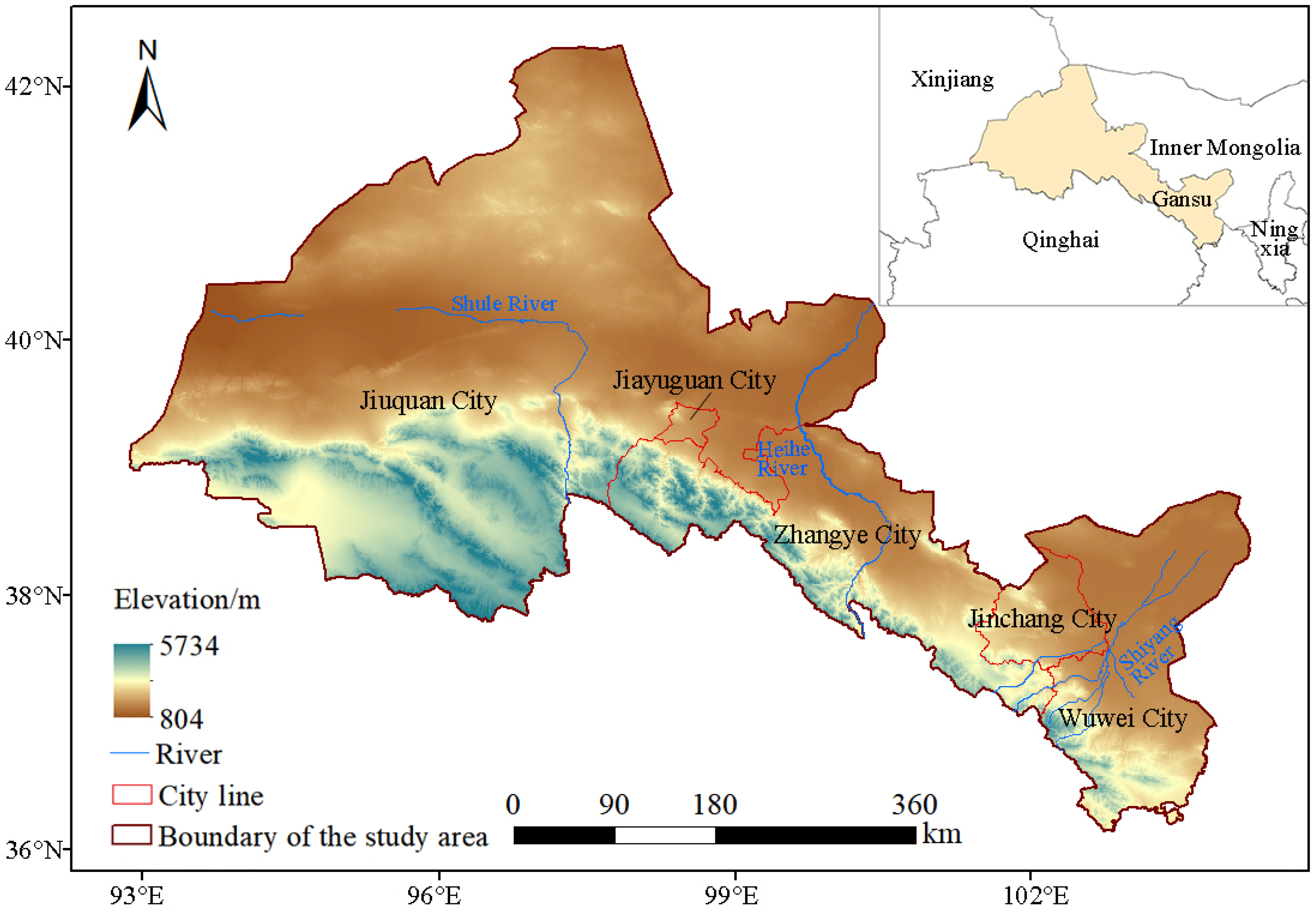

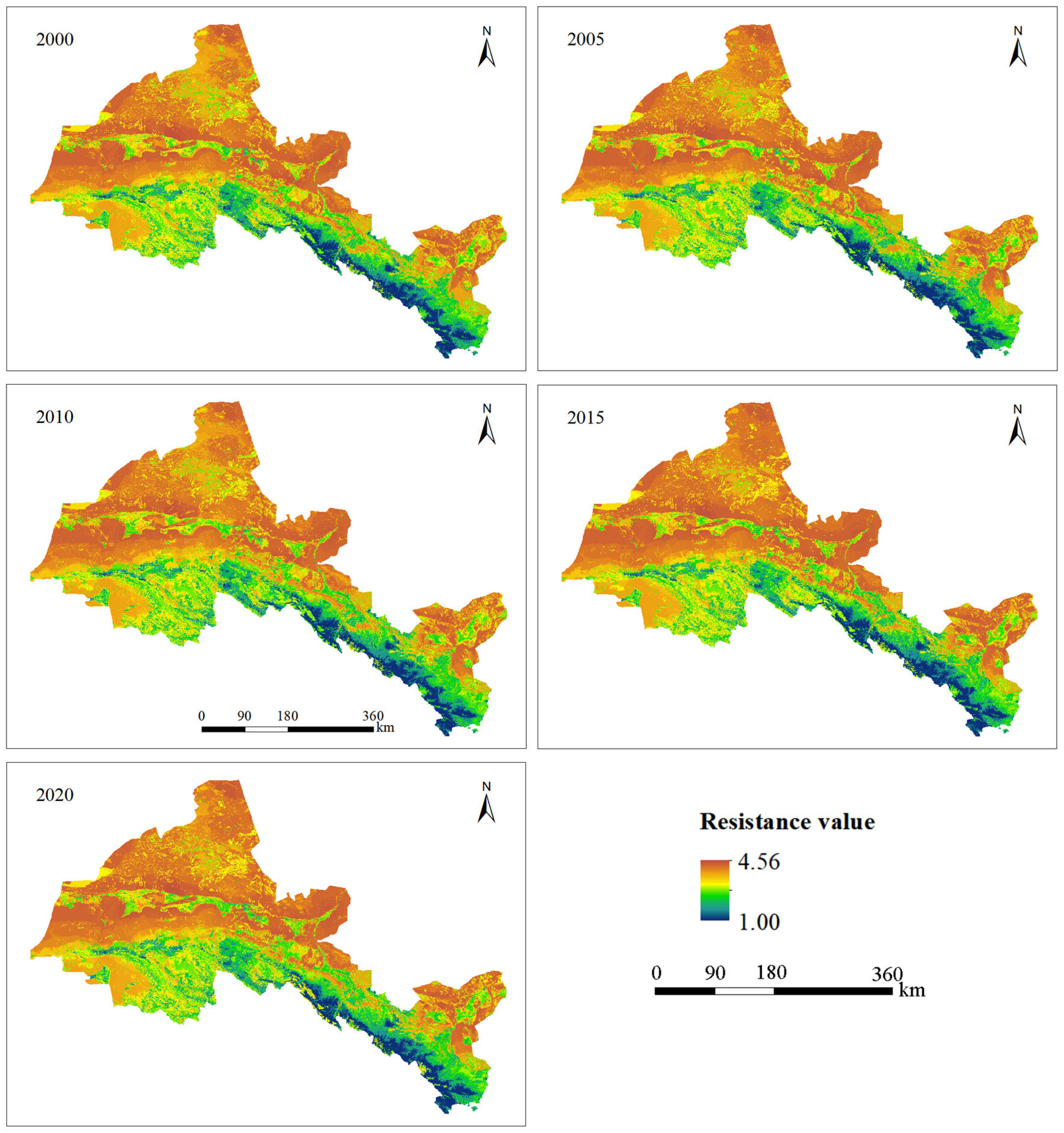
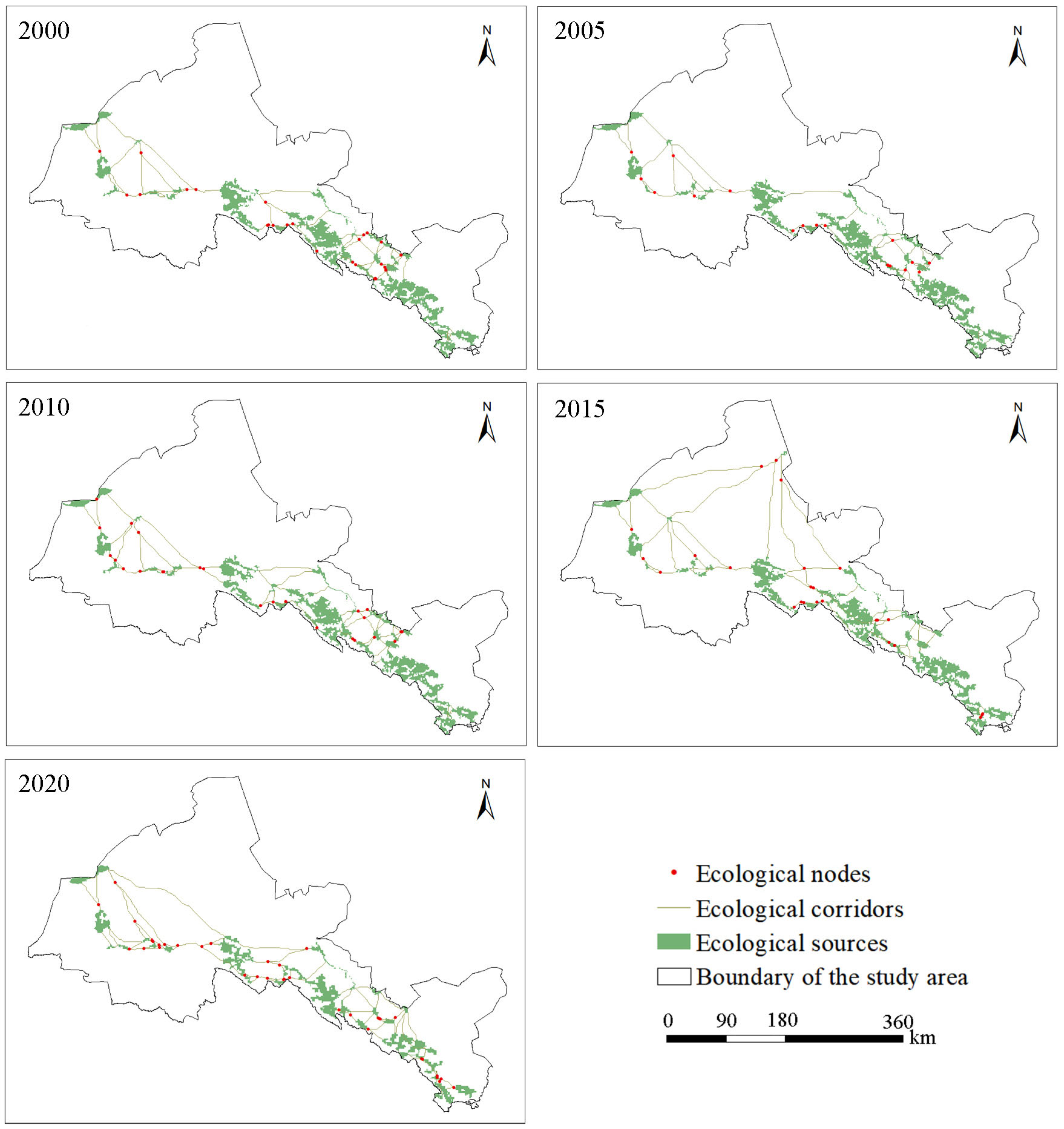
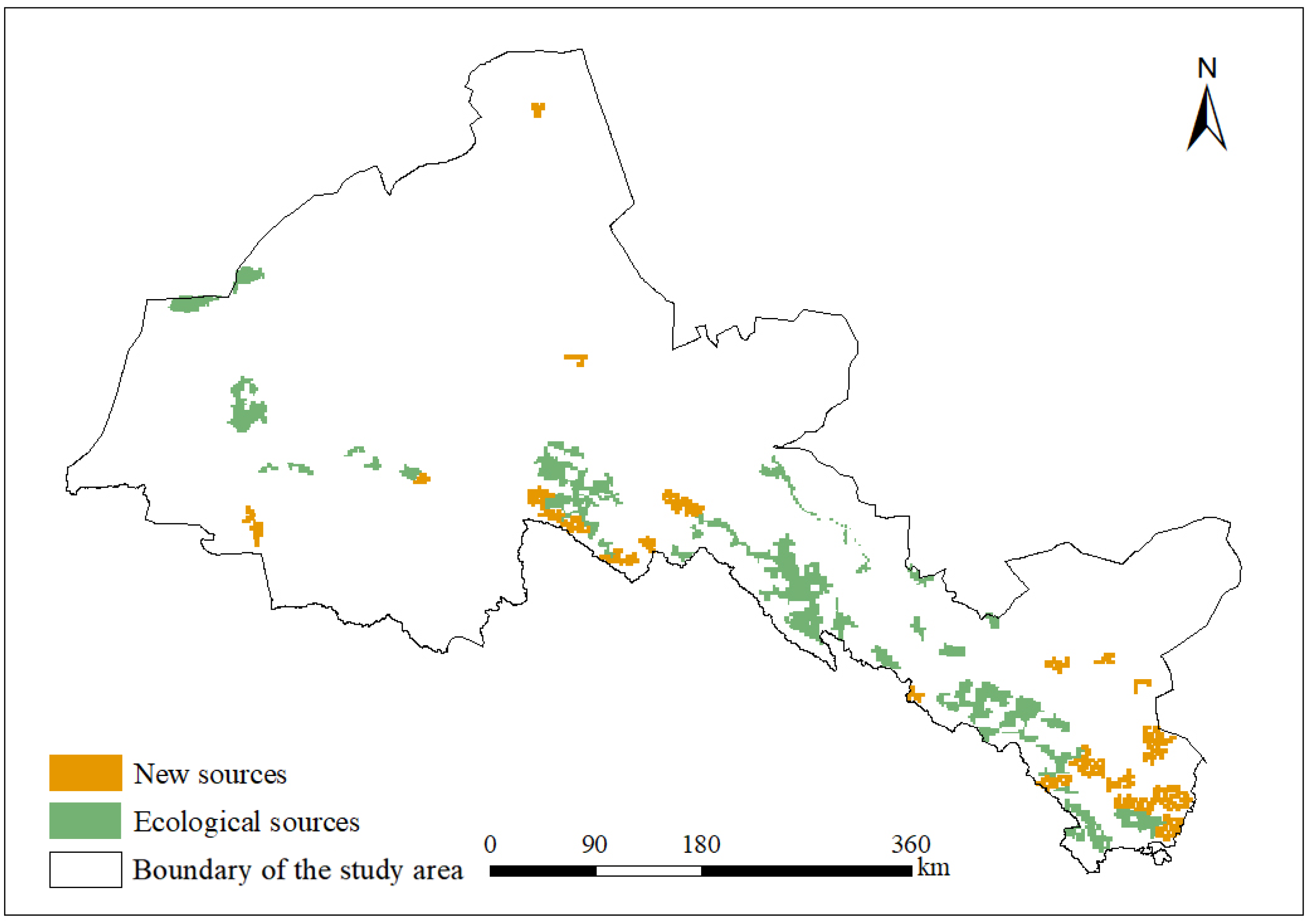
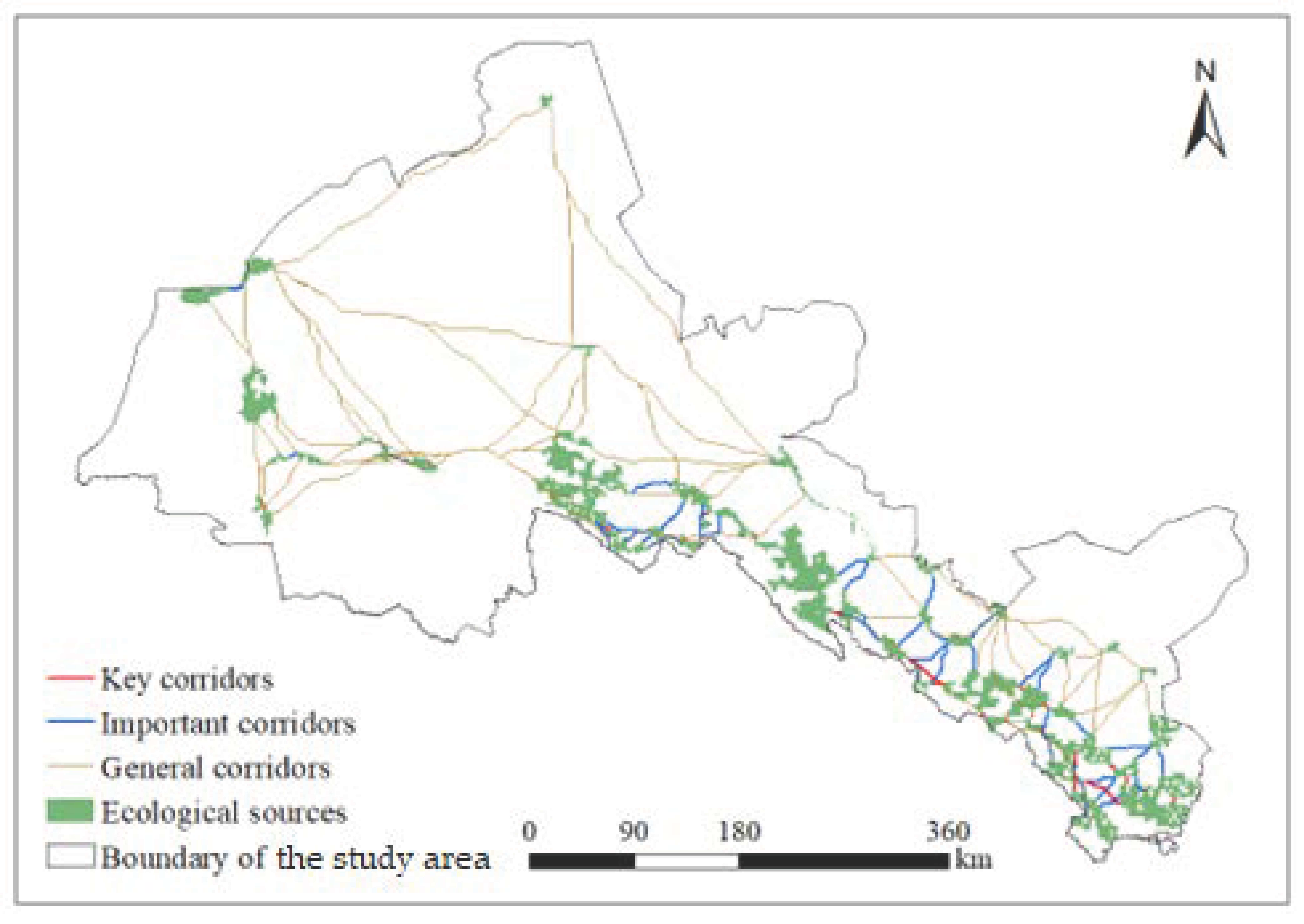
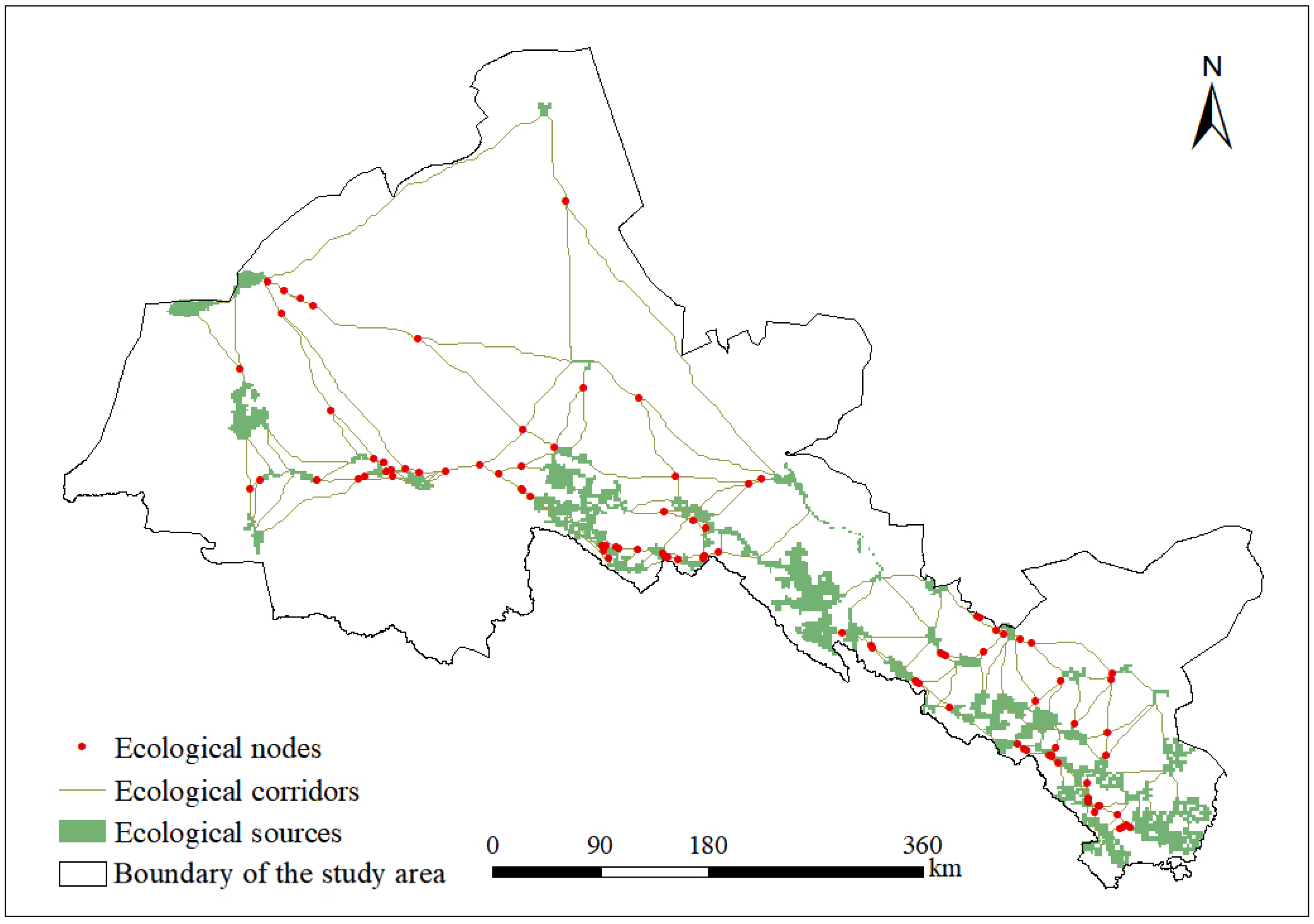
| Dataset | Resolution | Source |
|---|---|---|
| DEM | 250 m | Institute of Geographic Sciences and Natural Resources Research (http://www.resdc.cn/ (accessed on 21 November 2023)) |
| Land use | 1 km | |
| NDVI | ||
| Water network data | — | Open Street Map (https://www.openstreetmap.org/ (accessed on 21 November 2023)) |
| Road network data |
| Landscape Type | Ecological Significance and Function |
|---|---|
| Core | Biological processes that start on large areas of land. |
| Bridge | Biological processes that start on large areas of land. Species can move between core areas that are close to each other and have a small space between them. This also allows energy to flow between them. |
| Edge | Because of the edge, noise from the outside cannot get into the core room. |
| Branch | The edge zone, hole, bridge zone, and loop line are all linked to the same end. |
| Loop | The biological passage lets species move through the same core area. This corridor also lets things and energy flow. |
| Islet | Some spots are spread out and do not easily connect to each other. |
| Perforation | This is the difference between the main area and the background inside the main area. It is on the inside edge of the core area. |
| Resistance Factor | Classification Index | Resistance Value | Weight |
|---|---|---|---|
| Elevation/m | 0–1500 | 1 | 0.14 |
| 1500–2000 | 2 | ||
| 2000–2500 | 3 | ||
| 2500–3500 | 4 | ||
| >3500 | 5 | ||
| Slope/° | 0–8 | 1 | 0.10 |
| 8–15 | 2 | ||
| 15–25 | 3 | ||
| 25–35 | 4 | ||
| >35 | 5 | ||
| NDVI | >0.70 | 1 | 0.25 |
| 0.50–0.70 | 2 | ||
| 0.30–0.50 | 3 | ||
| 0.10–0.30 | 4 | ||
| 0.00–0.10 | 5 | ||
| Land use | Forest, shrub, sparse forest, high-coverage grasslands, lakes, canals | 1 | 0.41 |
| Land covered with grassland, marsh, reservoir pits | 2 | ||
| Other woodland, low-cover grassland, permanent glacial snow, dry land | 3 | ||
| beaches, saline-alkali land, bare soil, other | 4 | ||
| urban land, rural resident land, other construction land, bare rock gravel land, gobi, sandy land | 5 | ||
| Road network density | 0.00–6.50 | 1 | 0.06 |
| 6.50–16.00 | 2 | ||
| 16.00–29.20 | 3 | ||
| 29.20–48.30 | 4 | ||
| 48.30–90.65 | 5 | ||
| Water network density | 0.05–0.08 | 1 | 0.04 |
| 0.03–0.05 | 2 | ||
| 0.02–0.03 | 3 | ||
| 0.01–0.02 | 4 | ||
| 0.00–0.01 | 5 |
| Time | Core | Bridge | Edge | Branch | Loop | Islet | Perforation | Area/×104 km2 | Total |
|---|---|---|---|---|---|---|---|---|---|
| 2000 | 7.70 | 4.31 | 3.59 | 3.26 | 1.17 | 5.34 | 0.26 | 6.34 | 25.63 |
| 2005 | 7.65 | 4.12 | 3.57 | 3.25 | 1.26 | 5.37 | 0.25 | 6.30 | 25.46 |
| 2010 | 7.60 | 4.24 | 3.62 | 3.26 | 1.19 | 5.27 | 0.29 | 6.31 | 25.47 |
| 2015 | 7.59 | 4.13 | 3.57 | 3.23 | 1.20 | 5.44 | 0.26 | 6.29 | 25.41 |
| 2020 | 5.14 | 8.38 | 1.58 | 1.55 | 1.95 | 6.76 | 0.14 | 6.30 | 25.49 |
| Trend |  |  |  |  |  |  |  |  | |
| Time | Ecological Source | Ecological Corridor | Longest Corridor/km | Ecological Node | α | β | γ |
|---|---|---|---|---|---|---|---|
| 2000 | 26 | 61 | 212.39 | 27 | 0.72 | 2.35 | 0.85 |
| 2005 | 28 | 61 | 212.49 | 18 | 0.67 | 2.18 | 0.78 |
| 2010 | 28 | 65 | 212.98 | 25 | 0.75 | 2.32 | 0.83 |
| 2015 | 28 | 63 | 533.13 | 25 | 0.71 | 2.25 | 0.81 |
| 2020 | 32 | 75 | 301.58 | 36 | 0.75 | 2.34 | 0.83 |
| Trend |  |  |  |  |  |  | |
| Network Evaluation Index | α | β | γ |
|---|---|---|---|
| Before optimization | 0.75 | 2.34 | 0.83 |
| After optimization | 0.98 | 2.85 | 0.98 |
| Change | 0.23 | 0.51 | 0.15 |
Disclaimer/Publisher’s Note: The statements, opinions and data contained in all publications are solely those of the individual author(s) and contributor(s) and not of MDPI and/or the editor(s). MDPI and/or the editor(s) disclaim responsibility for any injury to people or property resulting from any ideas, methods, instructions or products referred to in the content. |
© 2024 by the authors. Licensee MDPI, Basel, Switzerland. This article is an open access article distributed under the terms and conditions of the Creative Commons Attribution (CC BY) license (https://creativecommons.org/licenses/by/4.0/).
Share and Cite
Zhang, X.; Cui, X.; Liang, S. Evolution and Optimization of an Ecological Network in an Arid Region Based on MSPA-MCR: A Case Study of the Hexi Corridor. Sustainability 2024, 16, 1704. https://doi.org/10.3390/su16041704
Zhang X, Cui X, Liang S. Evolution and Optimization of an Ecological Network in an Arid Region Based on MSPA-MCR: A Case Study of the Hexi Corridor. Sustainability. 2024; 16(4):1704. https://doi.org/10.3390/su16041704
Chicago/Turabian StyleZhang, Xifeng, Xiaowei Cui, and Shuiming Liang. 2024. "Evolution and Optimization of an Ecological Network in an Arid Region Based on MSPA-MCR: A Case Study of the Hexi Corridor" Sustainability 16, no. 4: 1704. https://doi.org/10.3390/su16041704
APA StyleZhang, X., Cui, X., & Liang, S. (2024). Evolution and Optimization of an Ecological Network in an Arid Region Based on MSPA-MCR: A Case Study of the Hexi Corridor. Sustainability, 16(4), 1704. https://doi.org/10.3390/su16041704







